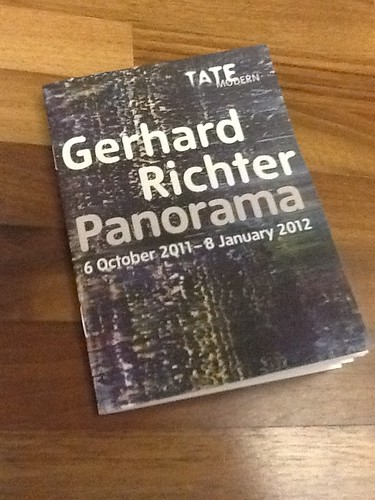I was fortunate the other day to be able to visit the Tate Modern in London whilst in the big smoke for a meeting just around the corner. I was particularly keen to visit, following a review I heard on BBC R4 about the exhibition currently showing the work of Gerhard Richter. I was not dissappointed, and neither was I alone - this proved to be a very popular attraction.
The paintings are a mix of very abstract and very figurative, but alway showing a quite phenomenal understanding of the nature both of paint as a material in itself, but also of the materials being depicted. The very abstract images were interesting, particularly the random colour squares, which your brain is desperate to interpret as a pixelated image. However, there is no hidden image to comprehend and the sense of disorientation is palpable.
I also enjoyed the photographs that have been painted over, blurred and distorted. It is as if they are rushing across the wall, and have just been caught in the exact moment they passed behind the frame - never quite in focus. Their fleeting presence is full of motion and disturbance. It seems as they will be lost again at any moment. There are some hugh images of clouds which you can't quite believe are paintings - the luminosity of the clouds is beautiful and the wispiness of the edges is perfect. But for all the realism, they are scale-less, without romanticism and quite unsettling.
Amongst the very abstract "squeegee" images are some smaller, almost photorealistic, paintings that are remarkable in their sense of materiality. One image - "Betty" is of a girl (Richter's daughter) viewed from behind, her face just turned away. She is wearing a fleece-like jumper that so captures the material you can almost feel it between your fingers. People peer closely at the painting, unable to believe it is made just of paint. There is also an image of a burning candle - a traditional study in play of light - where the sensation of glowing hot wax at the tip of the candle is incredible.
My personal favourite is the huge canvas of paris, which up close appears to be an abstracted jumble of brush strokes and paint texture. Step away, and the discernable shapes of Hausmann's Avenues begin to appear. Step away further and the buildings appear to be in ruinous, post-blitz state, bombed into broken carcasses.
I've heard Richter described as the greatest painter alive. I am in no way qualified to comment on that, but you leave the Tate thinking it is a very believable statement.
Gerhard Richter, Panorama. Tate Modern 6th October 2011 - 8th January 2012. Tickets required.


No comments:
Post a Comment